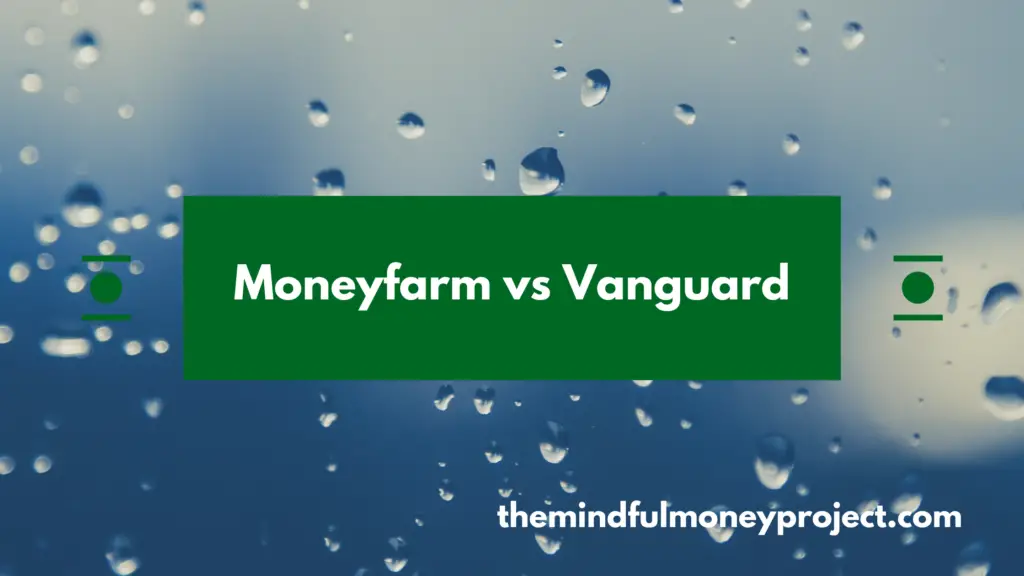Investing is the most impactful tool you have to reach an ambitious financial goal. Sometimes it can seem a bit of a scary world, other times the choice is overwhelming. You’re here today because you want to understand which of these two are more suitable for you. Both of these services are similar. After all, they intend to get you investing. One is an industry stalwart, one is a disruptive upstart. However, you’ll be clear of the differences between Moneyfarm and Vanguard once you’re done reading this article.
Quick summary
Best for those wanting simplicity and support: Moneyfarm*
Best for long-term index fund investors: Vanguard
The overall top pick has to be Vanguard due to the market-leading low fees and great options for index fund investors.
Moneyfarm
Pros
- Risk appetite questionnaire
- On-hand investment expert
- Ethical investment portfolios
Cons
- No passive investment portfolios
- £500 minimum investment
Vanguard
Pros
- Market leading low fees
- Great selection of funds
- Pioneer of index fund investing
Cons
- High minimum investment
- No initial advice/questionnaire
The head to head: Moneyfarm vs Vanguard
How we assess the head to head
In order to allow the best comparability, we’ll compare the services on the following dimensions:
- Investments available
- Availability of ethical investing options
- Account availability (ISA etc)
- Fees
- Existing customer reviews
- Minimum deposit requirements
- Platforms available
- FSCS protection
Before we start, it is worth saying that nothing in this article should be seen as financial advice. With all investing, your capital is at risk. Even though we regularly update our content, please do your own research before investing. If you require financial advice, you can search for a regulated and qualified financial advisor via the Personal Finance Society.
*Any links with an asterisk may be affiliate links. Even though we may receive a payment if you use this link to sign up for the service, it does not influence our editorial content and we remain independent. The views expressed are based on our own experience and independent analysis of the service.
Round 1: Investments Available
Moneyfarm
Moneyfarm is a robo advisor. They offer 7 globally diversified portfolios made up of a mix of funds and exchange traded fund(s). Each portfolio has a differing asset allocation intended to suit different investor’s risk appetites.
The more risky portfolios will have a higher weighting of stocks, whereas the lower risk portfolios will have a higher weighting of bonds.
Additionally, Moneyfarm is also regulated to offer investment advice. When signing up with Moneyfarm, you’ll answer a questionnaire that helps them to recommend you a portfolio matched to your risk appetite.
This is really useful, especially for first-time investors, as you may not know or understand your own risk appetite enough to make this decision without guidance.
Vanguard
Founded by John Bogle in 1975, Vanguard has become the champion of index fund investing. They are the world’s largest provider of mutual funds. Their offering is more of an investment platform that allows you to select and customise your own investments (as opposed to the more hand-holding provided by Moneyfarm’s service).
As a result, you can expect a range of Vanguard funds which should be sufficient for most investors.
Target Date Retirement Funds: these are a popular classic. You pick a fund that aligns with your expected target retirement date, and the fund will automatically change the asset allocation to a higher weighting of bonds as you approach this date. This reduces the volatility the closer you get to retirement.
Lifestrategy series: these are another popular choice, and essentially are the closest Vanguard option to the Moneyfarm portfolios. There is a range of Vanguard Lifestrategy funds, with the difference being their asset allocation. On the riskiest end is the 100% equity Lifestrategy fund, whilst the least risky is the Lifestrategy 20% Equity fund.
Regional/Themed funds: there is a wider range of funds available, for example, a FTSE Developed Europe fund and an All World ETF.
It is worth calling out that Vanguard do also offer a personal financial planning service. However, you’ll need to have at least £100k invested to gain access. If you’re looking for on-hand expertise then Moneyfarm’s service may be more for you.
Round 2: Ethical investing
Moneyfarm
They do offer a socially responsible version of each of their investment portfolios. These are constructed using data from MSCI, a leading global research firm specialising in Environmental, Social and Governance scoring (ESG).
However, if you’re looking to have control and visibility of each individual company that you are invested in, you’re better off using a more full service stock broker-type platform like Hargreaves Lansdown or Freetrade. The downside with selecting individual investments though is the difficulty in achieving diversification, the higher transaction fees involved in more actively trading your investments, and the increased time required to regularly rebalance your investments in line with your risk appetite.
Vanguard
A recent addition to the Vanguard suite of available investments is their SustainableLife funds (with varying levels of equity allocation, like active fund at 80-90%).
These are actively managed funds (so have higher fees compared to their other passive index funds/ETFs), which have sustainability policies applied to them such as excluding any companies that are involved in or derive revenue (above certain thresholds) from industries such as tobacco and nuclear.
Round 3: Accounts available
Moneyfarm
- General Investment Account
- Stocks and Shares ISA
- Personal Pension
Vanguard
- General Investment Account
- Stocks and Shares ISA
- Junior ISA
- Personal Pension
Round 4: Fees
Moneyfarm
Moneyfarm operates a tiered pricing structure based on the amount invested. This is made up of two parts:
- management fee/platform fee (this is the fee you pay for using Moneyfarm’s services)
- underlying investment fees (these are the fees you pay for the funds and investments Moneyfarm invests in)
The underlying fee remains flat at 0.29%.
However, the management fee is tiered:
- From £500 – £10,000: 0.75%
- £10,001 – £50,000: 0.6%
- £50,001 – £100,000: 0.5%
- £100,001+: 0.35%
Vanguard
The Vanguard account has a simple pricing structure. There is a simple platform fee of 0.15% per year, capped at £375 for accounts over £250,000.
The underlying fund costs vary depending on what you invest in, but pulling out some examples of popular Vanguard funds you can see how low they are:
- Vanguard Lifestrategy 80%: 0.22%
- Target Date Retirement 2045 Fund: 0.24%
- FTSE All-World UCITS ETF: 0.22%
So assuming you built up an investment portfolio of £10,000, you would be paying:
Moneyfarm: (0.75% x £10,000) + (0.29% x £10,000) = £104 per year (or 1.04% per year)
Vanguard: (0.15% x £10,000) + (0.22% x £10,000) = £37 per year (or 0.37% per year)**
Therefore Vanguard is significantly cheaper. The example above is only with small invested amounts of £10,000, but this difference of ~0.6% per year is massive, and this difference will compound over time.
**using an example fund of Vanguard Lifestrategy 80% with an underlying fund fee of 0.22%.
Related article: see why fees are so important in the first section of this article.
Round 5: Existing customer reviews
Moneyfarm
An average of 4.7/5 on Trustpilot from 655 reviews at time of writing. Positive reviews discuss the ease of using the platform and the design, as well as the access to the investment expert on hand. However, some negative reviews discuss slow handling of transfers and withdrawals.
Vanguard
Rated 4.2/5 on Trustpilot with 1,260 reviews at time of writing. Positive reviews discuss the low fees, trust-worthy name and ease of using the site. Negative reviews commonly mention transfers and slow handling times (of either transfers or withdrawals).
Round 6: Minimum deposit requirements
Moneyfarm requires a £500 minimum investment.
Vanguard requires to either invest a lump sum of £500, or if looking to do monthly investments then a minimum of £100 per month (or a combination of the two). Once you’ve set up the account, you can add whatever amounts you like.
Round 7: Withdrawal restrictions
Moneyfarm
There are no restrictions on the accounts (other than the standard Pension restrictions where you cannot withdraw until you are 55). Withdrawals take up to 7 working days, and there are no fees or penalties.
Vanguard
There are no restrictions on the accounts (similar to Moneyfarm, restrictions apply on the pension where you cannot withdraw before pension age). Withdrawals require you to sell your funds first, which may take a few working days but can vary.
Round 8: Platforms available
Moneyfarm can be accessed online via the browser, as well as having both an iOS and Android app to monitor your portfolio on the go.
Vanguard can only be accessed online via the browser.
Round 9: FSCS protection
Both firms are authorised with the Financial Conduct Authority (FCA) and are both covered by the Financial Services Compensation Scheme (FSCS) deposit guarantee scheme.
Does Moneyfarm have FSCS protection?
Yes, Moneyfarm is covered by FSCS protection up to the first £85,000 are covered by the UK deposit guarantee scheme.
Does Vanguard have FSCS protection?
Yes, Vanguard does have FSCS protection. This is up to the first £85,000 covered by the UK deposit guarantee scheme.
Alternatives to Moneyfarm and Vanguard
You can find similar robo advisers with Nutmeg, Moneybox and Wealthify.
Whereas a similar platform allowing you to build your own portfolio can be found with Freetrade*, Stake* and Hargreaves Lansdown*. However, these platforms can’t beat Vanguard for fees. We’ve compiled a roundup of the best investment apps for beginners you can find here.
Conclusion: Vanguard vs Moneyfarm
If you’re looking to invest, then good work on narrowing it down. These are both great services.
Moneyfarm* is very much geared up for those newer to investing or who want a completely hands-off experience. You fill in the risk questionnaire, set up your automatic investments and then leave it. However, you pay more for this convenience.
Vanguard, on the other hand, will require you to select your own investments. This is not as stressful as it sounds though, as they have created some exceptionally beginner-friendly funds in the Target Date Retirement Funds and LifeStrategy funds. You’ll need to figure out your own risk appetite, but you’ll be rewarded with the lower fees that the Vanguard platform offers.
Have you had experience with both of these platforms? If so, I would love to hear your opinion on the head to head; Moneyfarm vs Vanguard. Drop a comment in the section below.





